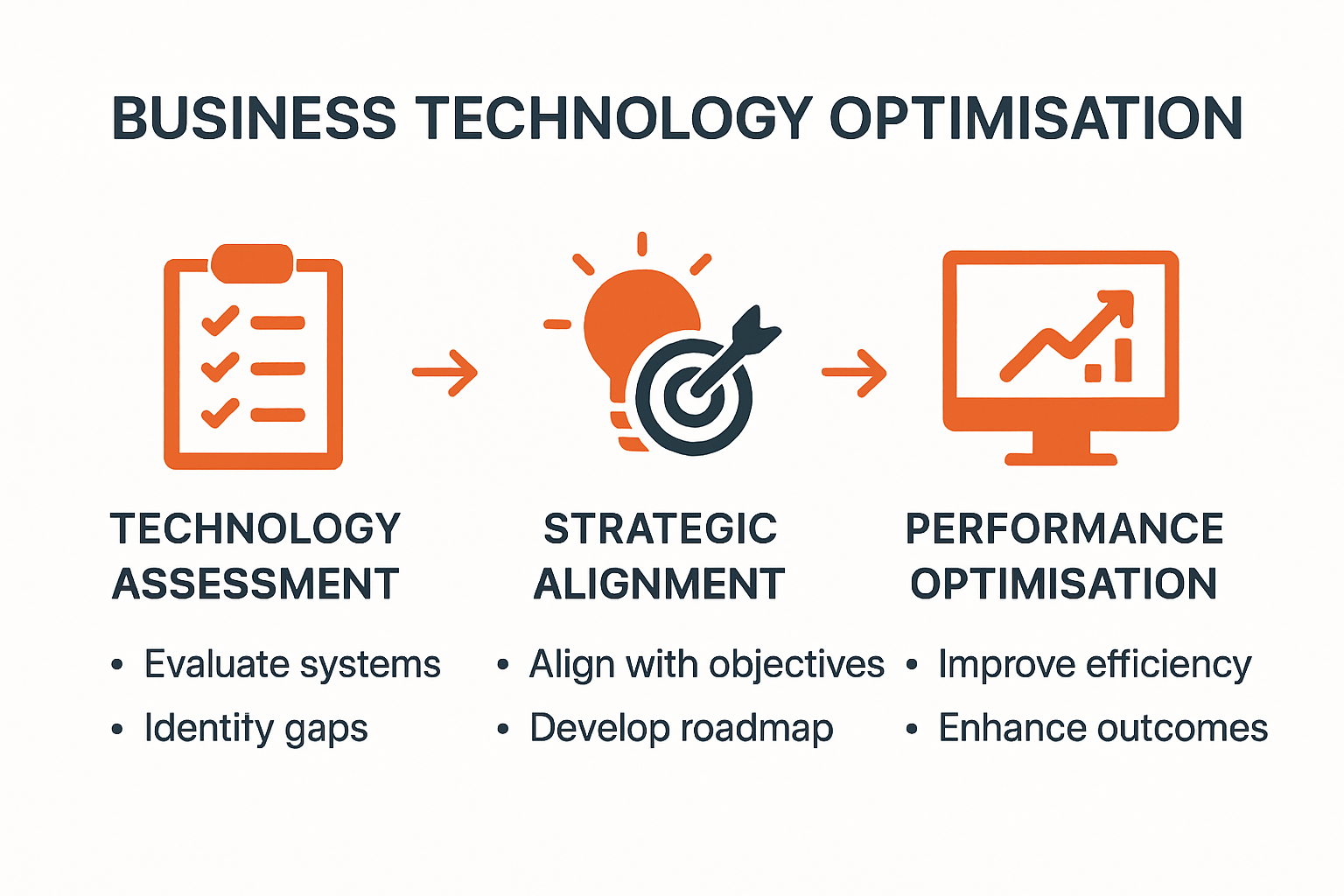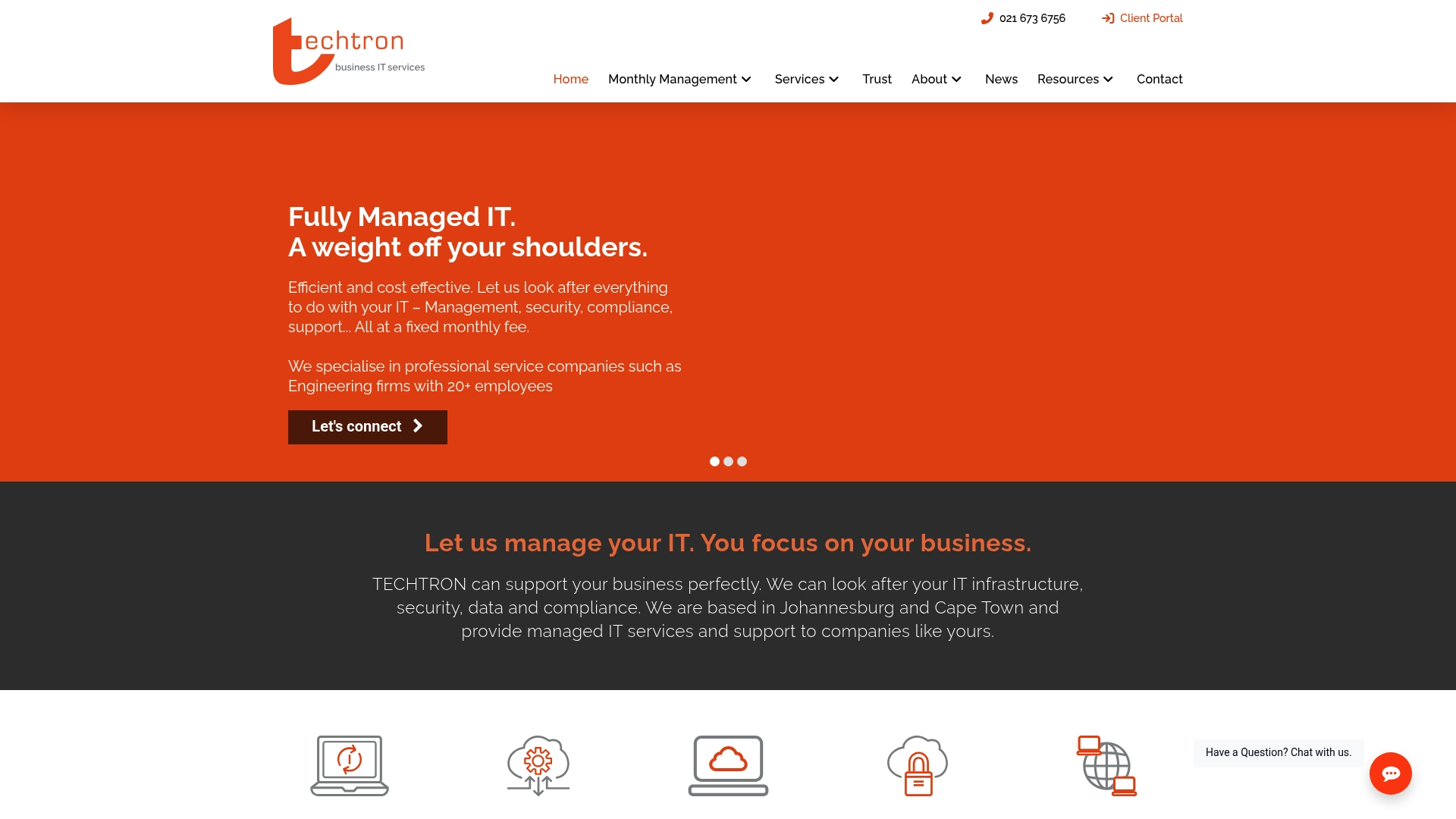Business Technology Optimization for 2025: Key Strategies and Benefits

Everyone wants their business to run smoother and faster with technology, but most companies miss out on the real prize. Believe it or not, 47 percent of organisations have experienced multiple cybersecurity incidents in South Africa. That’s not just a tech hiccup, it’s a harsh warning. The shocking part is, the biggest gains for 2025 aren’t just about installing new software or buying fancy hardware. The leading edge is all about combining smart digital upgrades with skilled people and strategic thinking, which flips the whole IT game on its head.
Table of Contents
- Understanding Business Technology Optimization
- Core Strategies For Mid-Sized Companies
- Ensuring Cybersecurity And Data Protection
- Leveraging Outsourced IT And Future Trends
Quick Summary
| Takeaway | Explanation |
|---|---|
| Business Technology Optimization is Ongoing | Organizations must engage in continuous evaluation, adaptation, and improvement of their technological infrastructures to achieve strategic alignment with business objectives and enhance operational efficiency. |
| Invest in Scalable Cloud Solutions | Mid-sized companies should prioritize cloud computing solutions that offer scalability and cost-effectiveness, enabling them to reduce infrastructure costs and enhance operational flexibility. |
| Prioritize Cybersecurity Measures | With high rates of cybersecurity incidents, businesses must develop comprehensive and proactive strategies for data protection, including risk assessment, threat detection, and skilled workforce development. |
| Strategic IT Outsourcing is Key | Businesses should view IT outsourcing as a strategic partnership that offers specialized expertise, scalability, and alignment with business goals to navigate technological challenges effectively. |
| Empower Organizational Capabilities | Investing in skills development, cultural transformation, and talent acquisition will significantly enhance technology adoption and integration, allowing businesses to leverage new technologies effectively. |
Understanding Business Technology Optimization
Business technology optimization represents a strategic approach that transforms how organizations leverage digital tools and systems to enhance operational efficiency, productivity, and competitive advantage. At its core, this process involves systematically evaluating, integrating, and improving technological infrastructure to align with specific business objectives.
The Strategic Foundations of Technology Optimization
Technology optimization goes beyond simple hardware upgrades or software implementations. According to a 2025 digital transformation study by McKinsey, it requires a holistic view that integrates technological capabilities with organizational strategy. This means analyzing existing technological ecosystems, identifying performance gaps, and developing targeted solutions that drive measurable business outcomes.
The process involves multiple critical dimensions. Technology assessment examines current infrastructure, identifying potential bottlenecks and inefficiencies. Strategic alignment ensures technological investments directly support business goals, whether that means improving customer experience, reducing operational costs, or enabling innovative service delivery. Performance optimization focuses on maximizing the utility and efficiency of existing technological resources.

Key Components of Effective Technology Optimization
Successful business technology optimization incorporates several essential elements. As research from the Gauteng Department of e-Government highlights, organizations must prioritize:
- Infrastructure Evaluation: Comprehensive assessment of current technological systems and their performance capabilities
- Strategic Planning: Developing a clear roadmap for technological integration and improvement
- Skills Development: Ensuring teams have the necessary digital competencies to leverage new technologies effectively
Moreover, Microsoft South Africa’s strategic investments demonstrate the importance of forward-thinking technological adaptation. By proactively identifying emerging technologies and understanding their potential impact, businesses can position themselves for sustainable growth and innovation.
Technology optimization is not a one-time event but a continuous process of evaluation, adaptation, and improvement. It requires organizations to remain agile, responsive to technological advancements, and committed to creating value through intelligent technological integration. The ultimate goal is not just implementing new technologies but transforming how businesses operate, compete, and deliver value in an increasingly digital world.
By embracing a comprehensive approach to business technology optimization, organizations can unlock significant competitive advantages, improve operational resilience, and create more dynamic, responsive business models that are prepared for future technological challenges and opportunities.
Core Strategies for Mid-Sized Companies
Mid-sized companies face unique technological challenges that require targeted strategies to remain competitive and resilient. These organizations must balance innovation with practical implementation, creating robust technological frameworks that drive growth while managing resource constraints.
Strategic Technology Investment and Alignment
Successful mid-sized companies recognize that technology optimization is not about massive expenditure but strategic, purposeful investment. According to McKinsey & Company’s research, embracing digitization and automation could generate substantial job opportunities and economic growth. This means carefully selecting technologies that directly contribute to business performance and operational efficiency.
The strategic approach involves conducting comprehensive technology audits, identifying gaps in current infrastructure, and developing targeted investment plans. Mid-sized companies should prioritize solutions that offer scalability, flexibility, and immediate operational improvements.
Organizational Capability and Technology Adoption
Technology adoption goes beyond purchasing new tools. Research from the South African Journal of Business Management highlights that organizational capabilities such as collaborative innovation, learning agility, and internal alignment significantly enhance technological integration.
Key strategies for mid-sized companies include:
- Skills Development: Investing in employee training and digital literacy programs
- Cultural Transformation: Creating an adaptive organizational culture that embraces technological change
- Talent Acquisition: Recruiting professionals with specialized technological expertise
Cloud Computing and Scalable Solutions
Cloud computing research indicates significant opportunities for mid-sized companies to improve competitiveness through scalable and cost-effective IT solutions. These technologies enable businesses to:
- Reduce infrastructure costs
- Enhance operational flexibility
- Support remote and hybrid work environments
- Implement advanced security protocols
The key is selecting cloud solutions that align with specific business requirements, ensuring seamless integration with existing systems and supporting long-term growth objectives.

By adopting a strategic, measured approach to technology optimization, mid-sized companies can transform technological challenges into competitive advantages. This requires continuous learning, adaptive strategies, and a commitment to creating value through intelligent technological integration.
Ensuring Cybersecurity and Data Protection
Cybersecurity and data protection have become critical priorities for businesses navigating an increasingly complex digital landscape. With technological advancements accelerating, organizations must develop comprehensive strategies to safeguard their digital assets and maintain operational integrity.
The Current Cybersecurity Landscape
To help you quickly understand the cybersecurity landscape discussed, here’s a table organizing the key statistics on security incidents in South African organizations:
| Cybersecurity Statistic | Percentage/Count |
|---|---|
| Organisations with multiple incidents | 47% |
| Organisations with at least one breach | 88% |
Research from the Council for Scientific and Industrial Research reveals a stark reality: 47% of organizations have experienced multiple cybersecurity incidents, with 88% reporting at least one security breach. This underscores the urgent need for robust protective measures.
A 2023 study on Fourth Industrial Revolution technologies highlights the direct correlation between technological advancement and increased cyber threats. As businesses integrate more complex digital systems, their vulnerability to sophisticated cyberattacks grows exponentially.
Strategic Cybersecurity Framework
For your reference, here is a table summarizing the core components of an effective cybersecurity framework as described in this article:
| Component | Purpose/Description |
|---|---|
| Comprehensive Risk Assessment | Identify vulnerabilities across infrastructure |
| Advanced Threat Detection | Implement intelligent monitoring systems |
| Incident Response Planning | Develop clear protocols for security breaches |
| Specialized Human Resources | Invest in skilled cybersecurity expertise |
Effective cybersecurity requires a multi-layered approach that extends beyond traditional security measures. Key components include:
- Comprehensive Risk Assessment: Identifying potential vulnerabilities across technological infrastructure
- Advanced Threat Detection: Implementing intelligent monitoring systems
- Incident Response Planning: Developing clear protocols for addressing potential security breaches
The University of Johannesburg’s cybersecurity training initiative underscores the importance of skilled human resources in maintaining robust digital defenses. Organizations must invest not just in technology, but in developing specialized cybersecurity expertise.
Holistic Data Protection Strategies
Data protection goes beyond preventing external threats. It encompasses a comprehensive approach to managing, securing, and maintaining the integrity of organizational data. This involves:
- Implementing encryption technologies
- Establishing clear data governance policies
- Creating secure backup and recovery systems
- Ensuring compliance with data protection regulations
Businesses must recognize that cybersecurity is not a one-time implementation but a continuous process of adaptation and improvement. The evolving nature of cyber threats requires constant vigilance, ongoing education, and a proactive approach to digital security.
By developing a comprehensive, strategic approach to cybersecurity and data protection, organizations can create resilient digital environments that protect critical assets, maintain customer trust, and support sustainable business growth. The goal is not just to defend against threats, but to build a robust, adaptive security ecosystem that can respond effectively to emerging challenges.
Leveraging Outsourced IT and Future Trends
The landscape of IT services is rapidly evolving, with outsourced IT solutions becoming increasingly critical for businesses seeking to maintain technological competitiveness and operational efficiency. Organizations are recognizing the strategic value of partnering with specialized IT service providers to navigate complex technological challenges.
Market Dynamics and Growth Potential
Statista research projects the South African IT outsourcing market will reach US$2.40 billion by 2025, with a compound annual growth rate of 6.33%. This substantial growth reflects the increasing demand for specialized technological expertise and scalable IT solutions.
According to TechCentral analysis, the IT services market is expected to expand from R104.9 billion in 2024 to R182 billion by 2028. This significant growth is driven by increasing demand for cloud services and digital transformation initiatives.
Strategic Considerations for IT Outsourcing
Effective IT outsourcing goes beyond cost reduction. Organizations must carefully evaluate potential partners based on several critical factors:
- Technical Expertise: Depth of specialized knowledge and technological capabilities
- Scalability: Ability to adapt services to changing business requirements
- Security Protocols: Robust cybersecurity and data protection mechanisms
- Strategic Alignment: Understanding of specific business objectives
The National Data and Cloud Policy, finalized in 2024, provides a comprehensive framework for data migration and cloud service adoption, offering greater confidence in outsourced IT solutions.
Future Technology Integration
Outsourced IT services are evolving to offer more than traditional support. Modern providers are becoming strategic partners that help businesses:
- Implement advanced technological solutions
- Navigate complex digital transformation processes
- Develop adaptive technological strategies
- Access cutting-edge technological expertise
Businesses that strategically leverage outsourced IT can transform technological challenges into competitive advantages. The key is selecting partners who offer not just technical support, but genuine strategic insight and forward-thinking technological solutions.
As technological complexity continues to increase, outsourced IT services will play an increasingly critical role in helping organizations remain agile, innovative, and technologically competitive. The most successful businesses will be those that view these partnerships as collaborative relationships focused on driving long-term technological and organizational growth.
Frequently Asked Questions
What is business technology optimization?
Business technology optimization is a strategic approach that focuses on enhancing operational efficiency and productivity by systematically evaluating and improving technology infrastructures to align with business objectives.
Why is cybersecurity important for technology optimization?
Cybersecurity is essential for technology optimization as businesses face increased threats in the digital landscape. A robust cybersecurity strategy protects sensitive data and maintains operational integrity, which is critical for successful digital transformation.
How can mid-sized companies effectively invest in technology?
Mid-sized companies should prioritize strategic technology investments that directly contribute to business performance and operational efficiency, rather than focusing on massive expenditures. Conducting technology audits and identifying specific needs can guide effective investment.
What role does cloud computing play in business technology optimization?
Cloud computing provides scalable and cost-effective IT solutions that enable businesses to reduce infrastructure costs, support remote work, and implement advanced security measures, ultimately facilitating operational flexibility and efficiency.
Ready to Optimise Your Business Technology for the Future?
If you have felt the pressure of managing cybersecurity risks or struggling with outdated IT systems as outlined in our article, you are far from alone. Many mid-sized South African firms are grappling with rising threats, cloud integration headaches, and the challenge of keeping up with changing tech requirements. The article highlighted a real danger: nearly half of local organisations face multiple cybersecurity incidents. This is not the time for guesswork. Businesses need powerful, well-managed IT that links smart technology investments with skilled people and flawless security.

At Techtron, we make business technology optimisation practical and worry-free. Our tailored managed IT services cover everything from advanced cybersecurity to cloud solutions like Microsoft 365 and Azure. If your team is feeling the weight of technology challenges or if you need to protect sensitive data and ensure compliance, now is the right time to act. Discover how our trusted experts can help you align technology with your business goals, improve productivity, and secure your digital future. Visit Techtron today to get started or request a tailored consultation.